Beginner's Guide to the Didgeridoo
The didgeridoo is a wind instrument found among the Aborigine clans of northern Australia. Didgeridoos are usually produced in the more traditionally oriented communities of northern Australia from various hardwoods, especially the Eucalyptus trees that are hollowed out by termites. Didgeridoos can also be made from PVC piping. The mouthpiece is usually made of beeswax or duct tape, but a rubber stopper with a hole cut into it is also acceptable to use for the mouthpiece.
A modern didgeridoo is commonly shaped like a cylinder or cone and measures from 3.2 feet to 9.8 feet in length, with most measuring around 3.9 feet.
The length of the didgeridoo is directly related to the sound of the instrument. More specifically, the length of the instrument determines the pitch. A longer didgeridoo will produce a lower pitch or key.
The didgeridoo is played with lips that continuously vibrate to make the droning sound using a special breathing technique called circular breathing. This requires a person to breathe in through the nose while expelling air out of the mouth using the tongue and cheeks. By using circular breathing, a skilled didgeridoo player can fill up his lungs and hold a note for a very long time. There are recordings of some didgeridoo players playing for as long as forty minutes!
The didgeridoo can be played as a solo instrument, but is most often used to accompany dancing and singing in ceremonial rituals. For the Aborigines of northern Australia, the didgeridoo is used to accompany singers and dancers in religious rituals. Only men play the didgeridoo and sing during ceremonial occasions. Women have played the didgeridoo in informal situations, but it is taboo for an Aborigine woman to play the didgeridoo during a ceremony.
The didgeridoo has been used often with modern Celtic music. It is played alongside bagpipes in modern groups. Many ska bands have also used the didgeridoo in their music which has been influenced by ethnic cultures. The droning sound produced by the didgeridoo makes it an integral part of an instrumental ensemble from Celtic groups to modern day bands. A sliding didgeridoo made of plastic allows it to be played in the same manner as a trombone, while a keyed didgeridoo is played like a saxophone.
There are many different ways to play the didgeridoo to produce different musical tones. To produce the basic drone, you puff out your cheeks and push out your lips to blow air through your lips and allow them to vibrate and make a low pitched buzzing sound.
To create rhythms on the didgeridoo, you can bounce air through your buzzing lips, using your stomach muscles like you were expelling a belly laugh. You can also use your tongue to produce the same rhythm by putting the tip of your tongue just behind your upper front teeth and snap downward to mouth the word, "ta-ta-ta-ta." Another interesting rhythm can be produced on the didgeridoo by letting your cheeks puff out, squeezing them together slowly, and then allowing them to puff out again.
Lip shaping can produce various harmonies on the didgeridoo. Changing the shape of the opening between your two buzzing lips like you are whistling will produce a higher pitched sound. By mouthing vowels, you can produce various harmonies while droning.
Many sound effects can be produced while playing the didgeridoo. Slapping your tongue against the back of your mouth to the front of your mouth creates a sound like a bubble bursting. If you open and shut your jaw while droning, you can hear the dramatic harmonious drop in pitch that returns to the original note as you shut your jaw. Experimenting with your vocal chords will also add different pitches to your playing on the didgeridoo.
There is no end to the harmonious music that can be produced with various lip, tongue, and cheek movements on the didgeridoo. It can produce a low droning pitch or a higher melodious pitch, depending on where and how you place your lips on the mouthpiece of the didgeridoo.
Didgeridoo Buying Guide
- Beginner's Guide to the Didgeridoo
- Percussionist & Songwriter, Xavier Rudd
- Didgeridoo Playing Instructions
- The Elegant Eucalyptus Didgeridoo
- Didgeridoo Music: Performers and Recommended Recordings
- Basics Of Circular Breathing
- Didgeridoo Therapy
Recent Posts
-
X8 Drums Play-Along Backing Tracks
The new X8 Play-Along Series is being produced for our musician friends wanting a fresh way to work …9th Feb 2025 -
What is the Best Size Djembe for Beginners?
If you're new to the world of percussion and interested in learning the djembe, you're in for a t …16th Jul 2024 -
The Benefits of Becoming a Drumming Teacher: Transforming Passion into Profession
Why become a drumming teacher? Becoming a drumming teacher is an excellent way to share your pas …22nd May 2024



